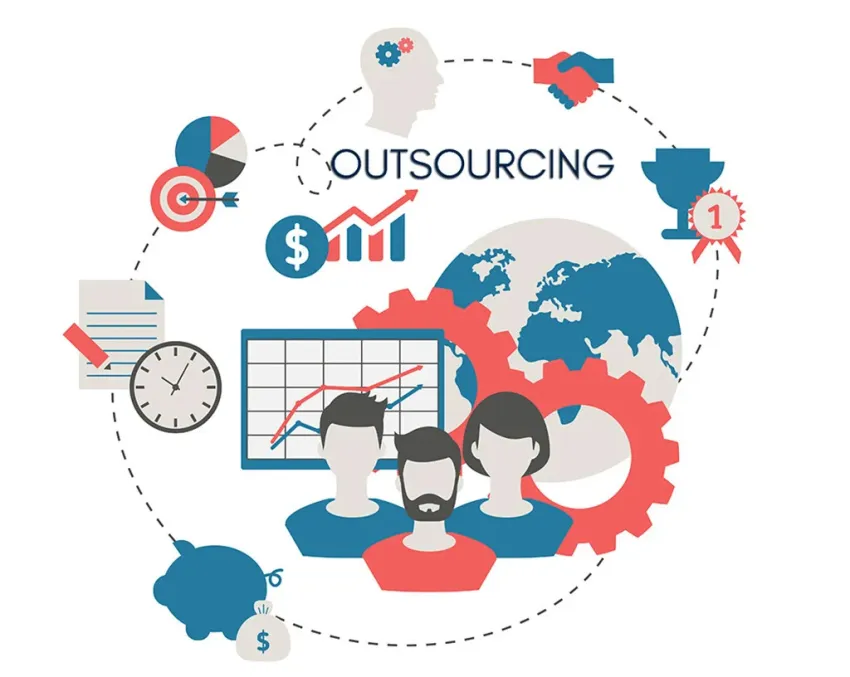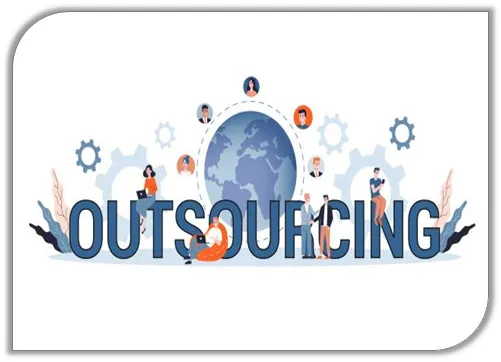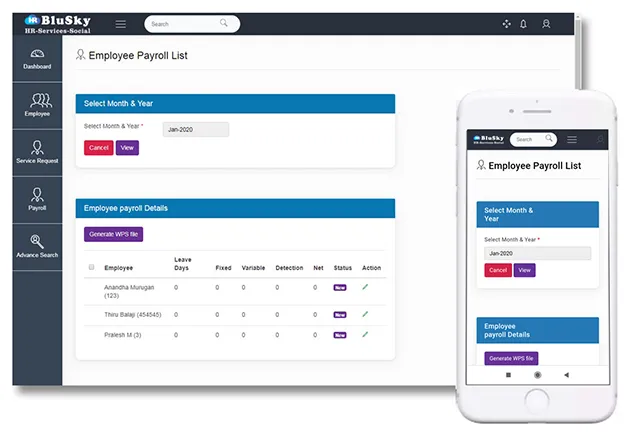
Menu

Menu

Are you interested in outsourcing the transactional parts of your HR services so that you can focus on the things that add more value? But are you also concerned about losing visibility?
In recent years, the acceptance of the value of outsourcing transactional HR tasks has significantly increased, particularly as organizations have faced mounting cost pressures. More importantly, this shift has coincided with HR’s embrace of the business partner role, which has become essential for organizational success. In this critical role, HR’s ability to contribute to various facets of the business—such as employee development, organizational development, and employee retention—has never been more vital. Furthermore, by fostering a positive and motivating work environment, HR plays a crucial role in enhancing overall business performance. Consequently, the integration of outsourced HR functions allows internal teams to focus on these strategic priorities, ultimately driving business success.

Outsourcing allows companies to offload work that isn’t part of their core business mission, which can, in turn, lead to significant cost savings. While some companies opt to outsource their HR needs to a single external service provider, it’s more common for them to segregate and outsource individual functions to a range of specialized external providers. This approach not only ensures that companies can tap into specific expertise for each function but also enhances flexibility in managing resources. Moreover, by leveraging specialized providers, organizations can access cutting-edge technologies and practices that may not be available in-house. Consequently, this strategy enables businesses to focus more on their core competencies while still benefiting from high-quality HR services.
There is no definitive list of what an organization should or should not outsource; rather, the decision typically hinges on various factors such as the type of company, its strategic focus, and the role that HR needs to play in helping achieve the organization’s goals. For instance, smaller businesses may find it more beneficial to outsource routine administrative tasks, allowing them to concentrate their resources on strategic initiatives. In contrast, larger organizations might choose to keep certain functions in-house to maintain greater control and alignment with their overall mission. Ultimately, each organization must carefully evaluate its unique circumstances and objectives to determine the most effective outsourcing strategy.
♦ High-volume and contract recruitment
♦ Assessment and reference checking for new hires
♦ Payroll
♦ Benefits administration
♦ Creating/updating employee handbooks and policy manuals
♦ Training
♦ HR strategy
♦ Talent development
♦ Manpower and succession planning
♦ Performance management
♦ Organisation development

Here’s a step-by-step approach to help you decide what to outsource and what to keep in-house.
It’s important to begin by re-defining the strategy for HR in your organization. Specifically, consider what role HR needs to play to effectively drive the company mission. Furthermore, identify what objectives HR must achieve and how that success will be measured. At this critical juncture, it is essential to determine which HR functions contain elements that are unique or strategic to the overall success of your organization. By taking the time to thoughtfully assess these factors, you can create a more focused and impactful HR strategy that aligns with your business goals.
Any roles that HR manages outside of the elements defined in Step 1 can be considered for outsourcing. In this context, key factors to consider include potential cost avoidance, as well as the ease of segregation from associated functions for processing. Additionally, assess the internal expertise levels compared to those needed to operate effectively. For instance, focus on areas where regulations change frequently or those that require very specialized skills. By evaluating these considerations, organizations can make informed decisions about which HR functions may be more efficiently managed through outsourcing, ultimately enhancing operational effectiveness.
Compare the location, benefits, costs, and approaches of different potential partners to gain a comprehensive understanding of what each provider offers. Additionally, it is crucial to conduct thorough background checks to ensure that you make a well-informed decision. The relationship you establish with your service provider is, therefore, critical to your outsourcing success. Moreover, fostering open communication and collaboration will enhance this partnership, leading to better alignment with your organizational goals and increased overall satisfaction with the services rendered. By taking these steps, you can lay the foundation for a successful outsourcing arrangement that meets your business needs effectively.

Consider the option of having a one-stop-shop centralized service provider that can handle several functions, if such a provider is available. Moreover, it is essential to evaluate whether you can link external systems and processes with your Human Resource Management System (HRMS) to provide a seamless experience for employees. This integration not only enhances usability but also protects the integrity and accessibility of data for analysis and reporting. Furthermore, by ensuring that all systems work harmoniously together, you can significantly improve the efficiency of your HR operations while also providing employees with a more streamlined and user-friendly experience. Ultimately, this approach can lead to better data management and informed decision-making within your organization.
Another potentially cost-effective option is to engage a go-between company that contracts the full range of required services on your behalf. This approach not only saves you time and effort in negotiating and managing multiple contracts but also creates centralized accountability. Additionally, it speeds up the process of finding high-quality local service providers, which can significantly enhance the overall efficiency of your HR functions. By streamlining these processes, you allow your internal team to focus on more strategic initiatives while ensuring that all operational needs are met effectively. Ultimately, this solution can lead to improved service delivery and stronger relationships with external partners.
Outsourcing enables a company to focus on HR activities that hold the most strategic value, while simultaneously saving money and benefiting from the specialized expertise of outside firms. By delegating non-core tasks to external providers, organizations can streamline their operations and allocate resources more effectively. Consequently, this allows internal HR teams to concentrate on critical functions that drive organizational success, such as talent development and employee engagement. Ultimately, outsourcing not only enhances efficiency but also strengthens the overall strategic position of the company in the market.
You can effectively maintain control of important HR functions while simultaneously helping HR become a more efficient and effective player; however, you need to find trusted partners to achieve this. Why not take a closer look at HRBluSky, a UAE-based HRMS that provides unique, fully integrated service provision for key functions such as payroll, visa processing, medical benefits, travel, and more? Furthermore, HRBluSky ensures that you can manage all these functions seamlessly, alleviating any concerns about loss of visibility. In fact, you can manage requests and track processing directly from inside the system, allowing for a streamlined and transparent approach to HR management. Thus, HRBluSky not only simplifies your HR processes but also enhances your overall operational efficiency.
Providing employees with access to the company HRMS via their mobile devices significantly enhances the ability to meet the challenges being faced in today’s work environment. This approach not only enables employees to access all core functions, such as benefit information, claim processing, and training and development, but it also empowers HR teams to utilize the accessibility and availability of mobile devices. Consequently, HR teams can ensure that employees are kept informed of new regulations and procedures while remaining connected to one central source of information.
This connectivity is particularly critical in environments where being aware of and following the latest health and safety regulations can, quite literally, be a matter of life and death. Furthermore, in addition to the practical benefits of this approach, maintaining a sense of “normality” in routine cannot be underestimated regarding its impact on reducing stress and promoting positive mental health among employees. Thus, the implementation of mobile access to the HRMS not only streamlines operations but also fosters a supportive and informed workplace culture.
With a little creativity, training teams and management can effectively post the latest “how-to” videos on various platforms, such as WhatsApp, Instagram, or YouTube. This strategy enables employees to watch the videos wherever they are, right on their own phones. Consequently, it helps reach a wide employee base located in different areas while delivering a standardized message. Furthermore, this approach can easily be extended to allow employees to create content themselves and post it for colleagues to view. Not only does this practice encourage the sharing of good practices, but it also provides employees with a much-needed sense of “control” and engagement in their learning process. Therefore, leveraging these platforms can significantly enhance communication and collaboration within the organization, ultimately fostering a more connected and motivated workforce.

Setting up a group on an app such as WhatsApp not only encourages but also spreads tacit knowledge among employees, while simultaneously providing managers and supervisors with a way to maintain open communication. This proactive approach enables them to identify and correct mistaken ideas, misunderstandings, or problem areas before they escalate. Moreover, maintaining open communication channels helps people feel connected and safe, which is essential for fostering a positive workplace culture. Additionally, many employees are now becoming increasingly comfortable with virtual meeting applications such as Zoom.
These platforms enable team meetings to continue seamlessly, even when employees may be isolated due to remote work arrangements. It’s also important to note that the use of virtual meetings provides an effective method for keeping employees who are working from home connected to colleagues who are physically in the workplace. This connection is essential for maintaining team dynamics and often depends on coordinated workflows. Therefore, leveraging these communication tools can significantly enhance collaboration and strengthen the overall sense of community within the organization.
Placing mobile use at the centre of work operations has benefits not only for the employees but also for management. In addition to the shared benefits from improved communication, the following are also important advantages of this approach:
♦ Ability to quickly reach teams and individuals with important new information
♦ Improved speed in resolving issues
♦ Ability to process management tasks remotely – such as approving claims and leave requests, or processing payroll approvals
♦ Enabling supervisors and managers to continually engage and motivate when face to face engagement is restricted
♦ Driving productivity that might otherwise be severely impacted by the new working environment and regulations
♦ Maintaining record keeping and data gathering for management reporting

In short, now is the time when organisations should put aside any concerns and embrace the benefits that the use of mobile technology can bring to the organisation, management, and employees. At the heart of this is the ability to share a central HR system via the widest possible range of mobile devices.
If you want your organisation to gain an advantage in these turbulent times, take a look at HRBluSky, a comprehensive HRMS solution that prides itself on providing a full range of feature rich services via mobile devices.
Employees need to show their Emirates ID card and/or their insurance card to avail of healthcare services.
No. The law stipulates that employers cannot pass on the cost of the cover to their employees. The renewal of an employee’s visa is subject to the employee having appropriate medical insurance in place.

To ensure effective outsourcing, it is crucial to establish a clear HR strategy first. This strategy should define the specific roles and responsibilities of HR in driving the overall mission of the organization. Consequently, this clarity will help identify which functions are essential and which can be outsourced. Additionally, a well-defined strategy enables HR to align its goals with organizational objectives, thereby maximizing the overall impact of the HR function. Ultimately, this foundational step sets the stage for a successful outsourcing journey.
While outsourcing can provide numerous benefits, it is essential to maintain a balance between external services and in-house capabilities. By evaluating the strengths and weaknesses of both options, organizations can determine which functions should remain internal and which can be effectively managed externally. For instance, while payroll and benefits administration might be outsourced for efficiency, talent development and performance management may require an internal focus to align closely with the company’s culture and values. This balanced approach ensures that strategic HR initiatives are not compromised while leveraging external expertise.
Establishing strong communication channels with outsourced partners is vital for ensuring alignment and collaboration. Regular updates and feedback sessions help to maintain transparency and foster a sense of partnership. Furthermore, effective communication allows for quick resolution of issues and promotes a proactive approach to managing challenges. In addition, sharing insights and best practices with partners can lead to improved services and greater innovation, ultimately benefiting the entire organization. Thus, prioritizing communication can significantly enhance the effectiveness of outsourcing relationships.
In today’s digital age, technology plays a pivotal role in optimizing HR operations. By leveraging advanced HR management systems, organizations can automate routine tasks and enhance the overall efficiency of their HR functions. Moreover, integrating technology allows for seamless data flow and improved accessibility, enabling HR teams to make data-driven decisions. Additionally, technology fosters collaboration among employees, whether they are in the office or working remotely. Therefore, investing in the right technology not only streamlines processes but also positions organizations for future growth and success.
If you want to see how you can simplify managing your employee medical health insurance, visit us at HRBluSky.
Alignment
Article
Audit
Automation
Benefits
Candidate
Communication
Compliance
Digitalisation
Digital Technology
Diversity
Emirates Id Application
Employee Experience
ESS
Feedback
Health and Safety
HRMS
HR Strategy
HR System UAE
Human Resource Management
Human Resource Management Systems
Job Roles
Learning and Development
Onboarding
Outsource
Payroll
Payroll Management System
Payroll Processing
Performance
Performance Management
Personalisation
Recruit
Recruiting
Recruitment
Remote Working
Rewards
Security
Service Providers
Skills
Smart
Survey
Virtual
Visa Cancellation
Work Environment
Workforce
© 2025 Pruvity HR Solutions Pvt Ltd, Madurai, India
WhatsApp us